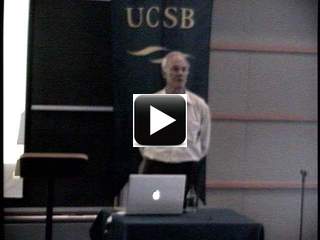Celebrating 25 Years of Santa Barbara as a Theoretical Physics Center
 Participants in the “Future of Physics,” Oct. 9, 2004. Photo by Nell Campbell.
Participants in the “Future of Physics,” Oct. 9, 2004. Photo by Nell Campbell.
"The Future of Physics" was the subject of a singular conference hosted by the Kavli Institute for Theoretical Physics last October. Over 150 of the world’s top theoretical physicists, including many Nobel laureates and leaders of the various physics fields, participated.
The conference was timed to coincide with the dedication of the new addition to Kohn Hall, which houses the KITP.
Most of the conference participants spoke, but they did not give their standard talks describing the status of their own research. In formats designed to enhance discussion, they identified, debated, and summarized the key developments in physics over the past 25 years; they assessed the current status of the physics fields; and they envisioned the course of physics over the next 25 years.
Commemorating the 25th anniversary of the Kavli Institute for Theoretical Physics under the aegis of the National Science Foundation (NSF), the conference aspired to be an event that epitomizes its mission.
“We aim through our programming to provide the intellectual equivalent of a lightning rod for physics and all its unfolding 21st-century ramifications — in terms of string theory, quantum computing, nanoscience, biological physics, and neuroscience — as well as for developments in the more traditional fields of 20th-century physics, such as particle and condensed matter physics and astrophysics.”
— KITP director David Gross
The final presentation of the conference addressed the questions that participants submitted beforehand as the key foci for developments in physics over the next quarter century. Gross gave that talk. Here are the questions:
- How did the universe begin?
- What is the nature of the dark matter that permeates the universe?
- What is the nature of the dark energy that causes the accelerated expansion of the universe?
- How are stars and planets formed?
- Does Einstein’s theory of general relativity work in situations of very strong gravity?
- Is quantum mechanics the ultimate description of nature?
- What is the origin of the strange spectrum of the masses of elementary particles?
- Is supersymmetry a true feature of nature? And where will it show up?
- Can we solve Quantum Chromodynamics (QCD)?
- What is string theory?
- What is the true nature of space and time?
- Is physics an environmental science?
- Should kinematics and dynamics be distinct?
- Are there new states of condensed solid matter?
- Can we develop a truly quantitative understanding of complex, chaotic dynamical systems?
- Will quantum computers be quiet or deaf?
- Is it possible to construct a room temperature superconductor?
- Is there a general theory of biology? Do we need to develop new mathematics for biology?
- Can we make genomics into a predictive science?
- What is the physical basis for consciousness? Can one measure the onset of consciousness in an infant?
- When will computers be able to be creative theoretical physicists, and how should we train them?
- Can physics remain unified and not split into various disciplines?
- Is the behavior of big things entirely determined, at least in principle, by that of the little things?
- What is the appropriate role of theoretical physics — the handmaiden of experiment or the achievement of a higher level of understanding?
- How do we deal with the serious dangers facing big science as new instruments become more and more expensive?
 |
Click above to play The Future of Physics or watch at http://online.kitp.ucsb.edu/online/kitp25/gross/
